SANDWOOD BAY AND CAPE
WRATH...... SEPTEMBER 2012

The noise.
Like being next to a busy motorway it was thunderous, deep, incessant, and tinged with menace.
In the aftermath of an Atlantic storm, the surf of Sandwood Bay heaved and banged and rolled.
Near to the most northwesterly point of the UK mainland, this remote beach is owned by the John Muir Trust. “Sandwood Bay is among the finest coastal scenery in Europe, with magnificent sands and dune systems, and a landmark sea stack, Am Buachaille, and further miles of wild cliff scenery”
The seaside then, but not as we know it. No habitation, no structures. With the wind whipping in from the west, it was a wild mixture of low clouds, salt spray, sand, and rock. Elemental and inhuman.
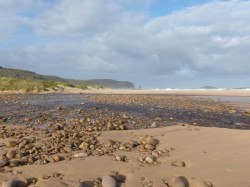
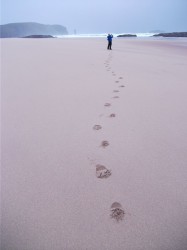
Water and wood were difficult, but not impossible. We also got plenty of big stones and put one on top of each tent peg.
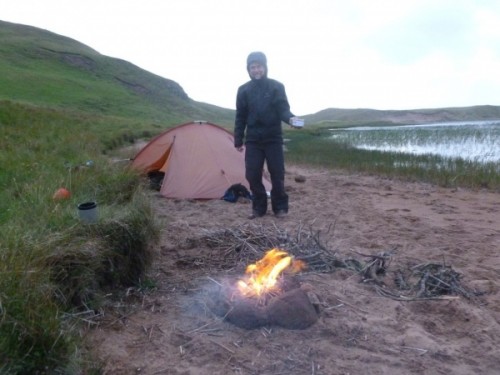
Our second day dawned sunny and clear. A joyous walk north for me and my friend Steve Whitehead, into the uninhabited square miles of moorland which becomes the Cape Wrath Firing Range. Heather, grass, streams; and cliffs dropping on our left hand to the still-foaming seas. Deer herds at close quarters. Birds.
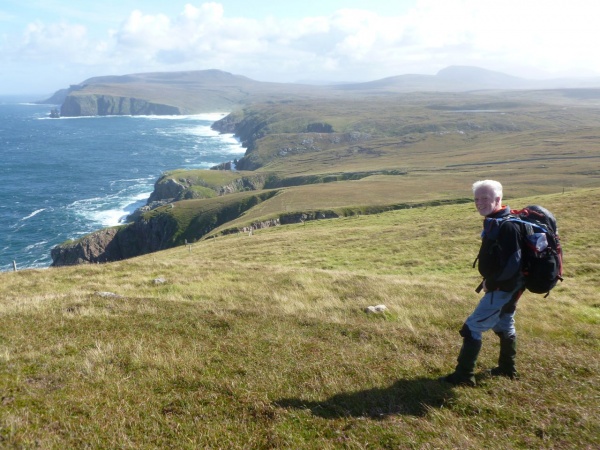
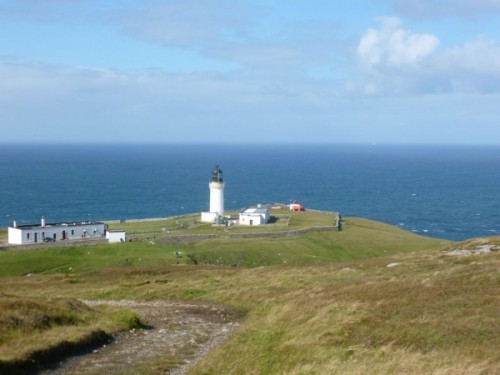
Finally the lighthouse. Here is the right-angle of land, the most remote of Britain's four corners, named (in Old Norse) for the turning-point where Viking ships from Dublin and the Isle of Man would turn east for the homeward leg of their journeys. The most narrow of roads threads its tiny and grass-grown way to the lighthouse, some 12 miles west it comes from a ferry across the Kyle of Durness at Keoldale. Tourists arrive by a minibus from the ferry to see this ultimate point.
Looking east now, we could see another sandy bay between sea stacks, about 4km distant, which holds the single tiny white house of Kearvaig bothy. So it was that in the sunny late afternoon we settled into the comfy bothy, walked the beach, and clambered out to see the stacks.
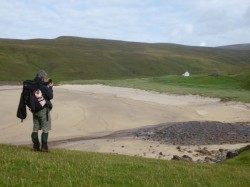
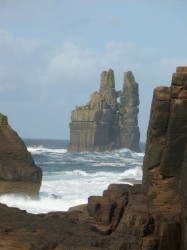
After the usual 4 courses and uisge beatha (the fabled Glenplatypus of course) we slept well, but not unaware of the growing noise of rain on the roof. 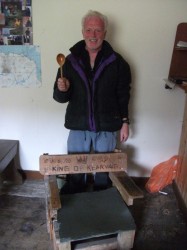
We left soon in the morning, under grey skies and steady rain.
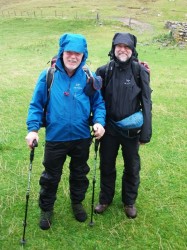
We'd jettisoned the idea of walking along one of Britain's highest sea cliffs (Cleit Dubh) in the strong wind and reducing visibility. As the bothy track emerged onto the open moor it got worse and worse. The wind was constant at around 50mph, always pushing, whistling round your head, and driving strong rain in near-horizontal grey sheets across the empty moorland. Hoods well down, wind on our backs, we were glad to have the tiny ribbon of lighthouse road to guide us, and tramped as quickly as we could, to get to shelter.
Eventually the track dropped down to sea level. At the ferry point, the only house was locked and empty. No shelter. No ferry.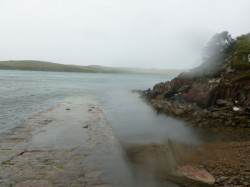
The Kyle of Durness is a sea inlet about 600 metres across at the ferry, and 7 km long. The white horses raged across the water, the howling wind pulling long plumes of white spray off them. Obviously the ferry wasn't coming (he didn't even answer the phone !) 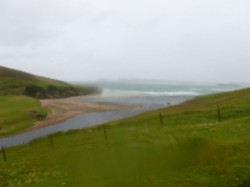
So we had to turn south, to make our way around the south end of the Kyle and reach the road.
Easier said than done !!. 800 metres south, an un-named stream, had swollen from its normally-tiny width to a boiling torrent hurling itself down a steep little gorge. Any attempt to cross would result in buckling at the knees and rapidly, a broken head. Heads down, uphill we went directly into the liquid blizzard. After a while, there was a confluence where we were just able to get across the separate strands.
Now came another half hour of contouring south-west, anxiously looking for the next stream which lies a mile away. Finally I saw a stone wall running up the hillside....... and OVER THE TOP of the wall, there appeared the surging, heaving, frightening white water of the Allt Coire Fresgill. This was even more impossible than the previous one !. We tried uphill into the storm for half a mile, but there was no sign of any likely place to cross. The options were now closing in:- I was quite prepared to break a window in the locked house at the ferry IF we could get back ;- however the waters were still rising as the rain poured madly down, and maybe we could not get back across the first stream anyway. The prospect of being trapped between the waters for maybe 2 or 3 days hardly bore contemplation ! The last hope was that Fresgill has (geologically) hurtled so much debris down the hillside, that a small delta has formed at the sea edge. Hardly the Nile, but the torrent levels out and splits into 5 channels. Under necessity, I got across these with the waters just above knee height. Steve followed. Praise be.
Now we ought to be out......... assuming that the footbridge over the Grudie River marked on the map was actually there. Otherwise, we were doubly trapped. Another kilometre along the strand brought us round the corner to the Grudie. This was the daddy of the lot !!. About as wide as a main road, and a huge roaring mass of white water. Was the bridge down ? or surrounded by flood water ?
Deo Gratia, it was there, and we crossed it.
The final "pitch" of this escapade, was yet another stream entering the Kyle. This one was not so steep, and ran smooth and dark. Which meant it was deep. Lying on the bank, I pushed my pole downwards to see if it would touch bottom. It didn't. Another search began.
Upstream was a wire fence -- fortunately sturdy -- which crosses the river. I took to this to cross about 3 metres of water which was running 2 metres deep. It swayed and leant !!
And so we escaped. We finally reached the road about 5 miles south of Durness, and having got from where we'd been, we were content to simply ignore the still-pouring rain until a car appeared from the murk to give us a lift !!
ANDREW
There was a young man from Cape Wrath
Who played "submarines" in the bath
He got into trouble
For blowing a bubble
So it's wise to stay out of his path.



